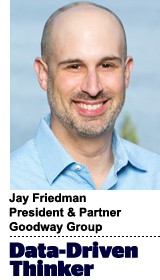 “Data-Driven Thinking” is written by members of the media community and contains fresh ideas on the digital revolution in media.
“Data-Driven Thinking” is written by members of the media community and contains fresh ideas on the digital revolution in media.
Today’s column is written by Jay Friedman, president and partner at Goodway Group.
On the heels of “Cachegate,” stones are being thrown at one ad tech company for what appears to be inappropriate behavior. I will not try that case here as I’m not an ad tech judge nor jury.
But, I do believe it’s fair to call out that the industry is throwing stones while many in ad tech still live in glass houses, or at least have one remaining glass wall in their house.
Rather than make this the 57th exposé on the industry, let’s stay positive and point out where ad tech can add yet even more value to help marketers accomplish their goals.
Supply-side platforms (SSPs) are an easy place to start since recent news has focused on this segment. First, of course, we don’t need 80-plus SSPs, but my suggestion that most should fold up shop and go home is likely to fall on deaf ears. What will work, though, is when marketers evaluate their SSPs and significantly reduce the number of SSPs with which they spend. Buyers consolidating spend will accelerate SSP Darwinism faster than any other force, and this is what’s best for the industry.
However, buyers can’t stop there. Buyers should insist on not buying “network” traffic from SSPs since there is likely a double mark-up in there somewhere and it keeps long-tail SSPs in business unnecessarily. Finally, buyers must explore SSP take rates. Some are higher than most marketers would be comfortable with. Heck, Facebook’s Audience Network specifically doesn’t disclose its take rate, so let your imagination run wild.
Demand-side platform (DSPs) can also better serve marketers and contribute to a better ecosystem. Every DSP should have an API that allows for both setup and administrative automation and bidding overrides. No DSP can build the perfect machine for every marketer, and some marketers and agencies are indeed smart enough to build a better single-use mousetrap than the DSP’s general purpose one.
DSPs should also make their entire platform’s data set available to customers in aggregate. DSPs currently hold an advantage over marketers because they see so many more bids and user instances than any one marketer can. Clearly, a marketer getting access to 100% of that data is not OK because it contains competitive intelligence. But if I want to build a lookalike model based on site visitation from a DSP’s data with its user IDs, what harm is there in having access to that data, even at the raw level, if I don’t know which customer bought each impression?
Verification providers are in a tough spot. To deliver a fraud-free, high-viewability world, they must aim to solve the problem but doing so would put them out of business. However, they aren’t nonprofits, and investors demand a sustainable business model.
It doesn’t have to be black and white, though. Verification providers see deep, valuable information about each impression – data that could help marketers be more productive rather than just being used to police rare violations.
For instance, while analyzing a webpage to verify brand safety, the technology could also help to provide context on what is driving a conversion on that same page. Or as part of their viewability offering, verification providers could help marketers understand how an ad’s time in view or specific URLs drive better and more meaningful engagement. Overall, simply using this technology for fraud detection, viewability and brand safety is selling this technology short, not to mention maintaining a business model that requires fear to sustain itself.
Data providers also have significant opportunity. Third-party data has tremendous value but its opacity leads many marketers to skepticism. We must get to a place where the data ingredients are more transparent. Someone glancing at information about a new pickup truck shouldn’t be put in the same bucket as someone who has spent more than an hour researching that same vehicle.
In my experience, a significant percentage of data segments are essentially identical. Data providers having 300,000 segments isn’t contributing to a better ecosystem if more than 150,000 of them are identical. Data providers should clean up the data, make it represent something and help marketers actually understand its value.
I believe ad tech has done more to help advertisers extract value from their advertising in the last five to seven years than was enabled for advertisers in the past 150 years. Being able to target a specific audience consuming specific content with firsthand knowledge of the audience’s resulting behavior was thought of as a utopia just 20 years ago. Now it’s here.
The remaining areas we can add value aren’t a reason to spend less in ad tech – they’re a reason to spend more. In doing so, we must direct spend to the right actors who add long-term value and do what’s right for marketers and users.
Follow Jay Friedman (@jaymfriedman) and AdExchanger (@adexchanger) on Twitter.
This post was syndicated from Ad Exchanger.


More Stories
M+AD takes break for Anzac Day commemoration
Sustainability Is More Than a Big Leafy Green Picture
Google Won’t Pull Cookies In 2024